REPUBLIC OF KOREA *
* By Mr. Lee Sang Yong, Director, Disabled Persons' Welfare Division, Ministry of Health and Welfare, Republic of Korea.
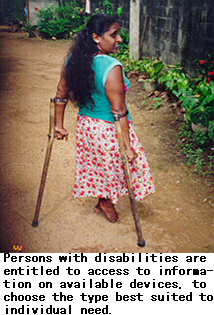
A. Need for assistive devices
The 1995 National Survey of Persons with Disabilities is a major source of information on assistive devices in the Republic of Korea, including items about the extent of possession, use and satisfaction with assistive devices. It found that 41.6 per cent of the country's people with disabilities have more than one assistive device; 70.6 per cent of people with disabilities who have assistive devices use them frequently.
Medical care insurance subsidizes the cost of many assistive devices. Devices are supplied free to people with low incomes and national meritorious people.
Several devices, components and materials are imported, nearly all through purchase rather than donation. The main sources of import are China, Germany, Japan, United Kingdom and the United States of America (see Table 1). Devices can be exempted from import duties when declared at customs. Still, about 70 to 80 per cent of assistive devices in the country are produced locally.
Table 1: Components Imported
| Type of device | Sources of imported components |
| Prostheses | Germany, Taiwan , province of China, United Kingdom, United States |
| Wheelchairs | Germany, Taiwan , province of China, United States |
| Braces | Germany, United States |
| Hearing aids | United States |
B. Policy
The Republic of Korea's policy on assistive devices provides for the following:
- (a) Tax reduction on assistive devices;
- (b) Support for research and development of assistive devices;
- (c) Customs duties exemption;
- (d) Medical care insurance subsidy on the cost of assistive devices;
- (e) Free distribution of assistive devices to low-income people and national meritorious people.
According to the Disabled Persons Welfare Law, the Ministry of Health and Welfare and provincial governments are responsible for the implementation of the policy.
National standards exist for some assistive devices, including crutches and accessories of braces. Current issues related to standardization are regulation of the range of assistive devices and systemization of the laws applied to assistive devices. The Commission of Korean Stan-dards for Industry, 13-31, Yu-Yee-Dodong, Young-Dung-Pogu, Seoul, is the national standards body concerned with assistive devices. It revises Korean standards every five years.
C. Production capacity
Few devices in the Republic of Korea are produced by the national or State government.
Table 2: Production Capacity
| Type of device | Units produced per month |
Estimated potential capacity
(units per month) |
| Prostheses | 1,600 | 3,000 |
| Orthoses | 1,200 | 2,500 |
| Wheelchairs | 600 | 1,200 |
| Hearing aids | 2,600 | 5,000 |
Table 2 indicates the surplus production capacity in the Republic of Korea. The likely reasons for this excess are unprofitability and an insufficient application of science and technology to assistive devices.
D. Repair and maintenance
Repair and maintenance services for assistive devices are generally provided by workshops intended for that purpose or for production of the devices. Some vehicle repair workshops repair wheelchairs, but carpentry and welding workshops rarely do.
E. Distribution
Assistive devices are distributed to people with disabilities in the Republic of Korea through production workshops. The devices can also be obtained free from the government, or through a medical care subsidy.
To obtain a device free from the government, a potential user can apply to the local government (town office) for a medical examination.
To obtain a medical care insurance subsidy, a user undergoes these steps:
- medical examination;
- purchase of assistive devices;
- examination of the adequacy of the devices;
- reimbursement of insurance by medical care insurance office.
see Table 3 for the cost of various types of devices produced in the Republic of Korea.
Table 3: Unit Cost by Type of Device
Prostheses
| Classification | Item | Cost (US$) |
| 1. Fore-quarter amputation | Fore-quarter amputation prosthesis Cosmetic Functional |
- 552.50 554.50 |
| 2. Shoulder amputation | Shoulder disarticulation amputation prosthesis Cosmetic Functional |
- 548.20 554.50 |
| 3. Above-elbow amputation | Short above-elbow amputation prosthesis Cosmetic Functional |
- 358.30 554.50 |
| Standard above-elbow amputation prosthesis Cosmetic Functional |
- 316.70 554.50 |
|
| 4. Elbow amputation | Elbow disarticulation amputation prosthesis Cosmetic Functional |
- 327.30 552.30 |
| 5. Below-elbow amputation | Very short below-elbow amputation prosthesis Cosmetic Functional |
- 378.20 250.00 |
| Short below-elbow amputation prosthesis Cosmetic Functional |
- 261.50 250.00 |
|
| Long below-elbow amputation prosthesis Cosmetic Functional |
- 261.50 250.00 |
|
| Wrist disarticulation amputation prosthesis Cosmetic Functional |
- 261.50 250.00 |
|
| 6. Partial hand amputation | Cosmetic partial hand amputation prosthesis or functional partial hand amputation prosthesis Cosmetic Functional |
- - 172.40 472.60 |
| 7. Thumb or finger amputation | Cosmetic thumb or finger amputation prosthesis |
- 73.30 |
| 8. Hind-quarter amputation | Hind-quarter amputation prosthesis | 1200.40 |
| 9. Hip amputation | Hip disarticulation prosthesis | 1200.40 |
| 10. Above-knee amputation | AK prosthesis a. standard b. silicon |
- 1074.80 351.30 |
| 11. Knee amputation | Knee disarticulation prosthesis a. standard b. silicon |
- 1075.90 227.30 |
| 12. Below-knee amputation | BK bent-knee end-bearing prosthesis a. standard b. silicon |
- 1075.90 227.30 |
| Very short BK amputation prosthesis a. standard b. silicon |
- 652.30 323.20 |
|
| Conventional or patellar tendon bearing below-knee amputation prosthesis a. standard b. silicon |
- - 583.90 386.40 |
|
| 13. Foot-joint amputation | Syme amputation prosthesis a. standard b. silicon |
- 528.20 215.90 |
| 14. Foot amputation | Foot amputation prosthesis a. standard b. silicon |
- 181.50 210.20 |
Orthoses and orthopaedic shoes
| Classification | Item | Cost (US$) |
| 1. Arm brace | Long arm brace a. long arm brace b. airplane splint |
- 204.90 317.90 |
| Short arm brace a. short arm brace b. universal Culf |
- 97.70 47.10 |
|
| 2. Spine brace | 2. Spine brace Cervical spine brace or Thomas soft collar Soft collar a. cervical brace b. Thomas soft collar c. cervical jacket |
- 135.50 51.50 411.60 |
| Dorsal, lumbar spinal brace a. knight type lumbar spinal brace b. Taylor type dorsal-lumbar spinal brace c. William type lumbosacral spinal brace d. Corset |
- 125.60 145.70 - 72.40 |
|
| 3. Pelvic band | Pelvic band | 129.50 |
| 4. Leg brace | Long leg brace a. long leg brace with pelvic band b. long leg brace without pelvic band |
- 346.50 320.50 |
| Bilateral long leg brace for paraplegic persons | 546.40 | |
| Knee cage a. knee cage b. Lenox Hill cage |
- 187.70 180.10 |
|
| Short leg brace a. ankle joint stop brace b. Klenzak type ankle joint brace c. 90º ankle joint stop brace d. Patellar tendon bearing brace e. plastic ankle foot orthosis |
- 234.70 251.70 165.80 281.00 81.30 |
|
| 5. Shoe | 5. Shoe Conventional shoe a. orthopaedic shoe b. high top shoe c. rocker bottom shoe |
- 129.20 141.70 133.00 |
Wheelchairs and Crutches
| Classification | Item | Cost (US$) |
| Wheelchairs | Wheelchairs | 340.90 |
| Crutches | Crutches | 17.70 |
F. Technology
The various types of technology and materials used to produce assistive devices in the Republic of Korea are too many and too diverse to list in this paper.
Several components are made within the country, for wheelchairs, hearing aids, braces and other devices. Many raw materials are indigenously available, including wood, aluminum leather, polypropylene and epoxy resin. New high-technology materials like titanium and carbon compounds have recently been introduced.
G. Personnel
Assistive device technicians in the Republic of Korea include prosthetists, orthotists, orthopaedic shoemakers, brace makers, mobility aid technicians, hearing aid makers and others.
A system of national qualification for assistive-device technicians does not currently exist. There is also no fixed form of curriculum for training them. Most training is through apprenticeship schemes, with some training through vocational colleges. See Tables 4 and 5 for a brief sample outline of the curricula for assistive-device technicians.
The Korea Orthopaedic and Prosthetics Association trains its members every year.
Technicians in the Republic of Korea are estimated to be employed in the following proportions: (in percentage terms)
| Self-employed | 20 |
| Private companies | 75 |
| Non-profit organizations | 5 |
| Government | 1 |
H. Institutional support
The government ministries providing institutional support for the indigenous production and distribution of assistive devices in the Republic of Korea are the Ministry of Health and Welfare, Ministry of Labour, and Ministry of Patriots' and Veterans' Affairs.
I. Technical cooperation
The Government of the Republic of Korea is interested in participating in exchanges of technical knowledge, as a host and as a beneficiary. The country's main area of need is for technical assistance in developing high-technology assistive devices.
Table 4: Curriculum for Prosthetists and Orthotists
Department of Rehabilitation Engineering, KyongBok Junior College
| Subject | Credit | Time(Theory) | Time(Practice) | |
| Culture | English 1 | 2 | 2 | - |
|---|---|---|---|---|
| English 2 | 2 | 2 | - | |
| Physical Education | 1 | - | 2 | |
| Computer Science | 3 | 3 | - | |
| Subtotal | 8 | 7 | 2 | |
| Compulsory Subject | Special Education | 3 | 3 | - |
| Rehabilitation Engineering | 3 | 3 | - | |
| Vocational Engineering | 3 | 3 | - | |
| Medical Education | 3 | 3 | - | |
| Assistive Devices | 3 | 2 | 2 | |
| Assessment & Evaluation | 3 | 2 | 2 | |
| Human Anatomy & Physiology | 2 | 2 | - | |
| Special lecture of Assistive Devices | 3 | 2 | 2 | |
| Clinical Medical lecture | 2 | 2 | - | |
| Health & Medical Act | 2 | 2 | - | |
| Medical Terminology | 2 | 2 | - | |
| Field Training | 3 | - | 6 | |
| Subtotal | 32 | 26 | 12 | |
| Elective Subject | Audiology | 3 | 3 | - |
| Human behavior & Environment Auditory Rehabilitation | 3 | 3 | - | |
| Engineering | 3 | 2 | 2 | |
| Developmental Phychology | 3 | 3 | - | |
| Welfare for the Handicapped | 2 | 2 | - | |
| Upper limb Orthoses | 2 | 1 | 1 | |
| Lower limb Orthoses | 2 | 1 | 2 | |
| Activities of Daily Living | 2 | - | 4 | |
| CAD for Assistive Devices | 2 | 2 | - | |
| Hearing Aids | 3 | 1 | 4 | |
| Rehabilitation Administration | 2 | 1 | 2 | |
| Rehabilitation Casting Method | 2 | - | 4 | |
| Rehabilitation Spinal Orthoses | 2 | - | 4 | |
| Upper limb Prosthesis | 2 | - | 4 | |
| Lower limb Prosthesis | 2 | - | 4 | |
| Rehabilitation Special Assistive Devices | 2 | - | 4 | |
| Rehabilitation Counselling | 3 | 3 | - | |
| Rehabilitation Mechanical Method | 2 | 2 | - | |
| Rehabilitation Therapy | 2 | 1 | 2 | |
| Rehabilitation Biomechanics | 2 | - | 4 | |
| Subtotal | 46 | 25 | 42 | |
| Sub Total | 86 | 58 | 56 |
Table 5: Curriculum for Hearing-Aid Technicians
HanGang-SungSim Hospital
| Credit | Time Theory | Practical | |
| Introduction to Audiology | 2 | 2 | - |
| Anatomy & Physiology of Hearing | 2 | 2 | - |
| Hearing Evaluation I | 2 | 1 | 2 |
| Introduction to Speech-Language Pathology | 1 | 1 | - |
| Psychoacoustic Measurement | 2 | 1 | 2 |
| Hearing Evaluation II | 2 | 1 | 2 |
| Hearing Conservation | 2 | 1 | 2 |
| Language Development | 1 | 1 | - |
| Phonetics | 1 | 1 | - |
| Articulation Disorder | 1 | 1 | - |
| Pediatric Audiology | 2 | 1 | 2 |
| Statistics | 2 | 2 | - |
| Hearing Aids Structure & Evaluation | 2 | 1 | 2 |
| Special Hearing Aids | 2 | 1 | 2 |
| Language Rehabilitation | 2 | 2 | - |
| Socio-psychology | 1 | 1 | - |
| Finger Language | 1 | 1 | - |
| Physio-Psychology | 2 | 2 | - |
| Field Observance | 1 | - | 3 |
| Field Training | 2 | - | 6 |
| Total | 33 | 23 | 23 |
SRI LANKA *
* By Ms. Pathagamage N. Chandralatha, Senior Physiotherapist, Department of Physical Medicine, General Hospital, Ragama; and Mr. Kabeeb M. Thoufeek, Senior Physiotherapist, Base Hospital, Trincomalee.
A. Need for assistive devices
According to community-based rehabilitation (CBR) resources in various parts of Sri Lanka, about 10 per cent of its population is disabled. The distribution of disabilities among them, in percentage terms, is:
| Locomotor | 65 |
| Mental | 23 |
| Visual | 7 |
| Speech and Hearing | 3 |
| Others | 2 |
Not all people with disabilities need assistive devices, but most do. The gap in the availability of assistive devices has been reduced to some extent due to CBR programmes launched in many parts of the island. In these, many devices are made at home by parents or volunteers with simple, freely available raw material.
Sixty per cent of the need for devices is met locally by specialized governmental organizations (such as rehabilitation hospitals and centres), the private sector, donations through NGOs, the Social Services Ministry, and relatives of persons with disabilities living abroad.
The other 40 per cent of the devices is imported from other countries, primarily India. In Sri Lanka, the private sector is the main source of import. India is the main source of donated devices. Among the imported materials are crutches (elbow and axillary), wheelchairs, calipers and other devices which are not produced in Sri Lanka.
If assistive devices are recommended and authorized by medical staff, no import duty is levied. Otherwise (when a relative sends a wheelchair from abroad to a local person with a disability, for example), a small duty must be paid. No difficulty is faced in getting devices through customs.
Sri Lanka has only two orthotic and prosthetic centres on the whole island, with a shortage of staff. There are no facilities for the production of assistive devices for people with non-locomotor disabilities.
The Jaipur Foot and prosthesis are helpful to Sri Lankan people with disabilities as these devices meet most of their needs well.
B. Policy
The Government of Sri Lanka has introduced loan facilities for local producers of devices, and also reduced duty on the import of appliances. Procedures for distribution of devices throughout the country must be reorganized, as the importing private-sector organizations are concentrated in the capital. According to CBR information, most people with disabilities are in peripheral regions.
C. Production capacity
It is difficult to have good statistics about the production of wheelchairs, as there are no large centres for their production. Local mechanics make wheelchairs according to the users' requests. There are only two centres for the production of calipers, prostheses, braces and other appliances. About 12 calipers, seven prostheses and 15 to 20 braces and other appliances can be produced at these two centres each month. The only devices produced for people with visual impairments are white canes. No devices are produced for people with hearing impairments.
Reasons for the limited production of devices include:
- A lack of technically qualified staff;
- High, unaffordable cost of devices;
- The reluctance of users to use devices that are culturally or physically inappropriate for their lives, even when those devices are given free of cost;
- A lack of financial resources.
D. Repair and maintenance
Centres producing or selling devices are situated in cities which have villages and towns within a radius of about 200 km. Devices taken to those areas are not generally brought to the capital for repairs. People find their own mechanics where they live. Facilities for maintenance are also poor. Fortunately, local carpenters and welders can repair some devices.
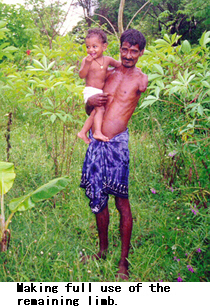 E. Distribution
E. Distribution
As most of the devices are provided by the government, the country's financial constraints make it difficult to distribute devices to all who need them. Through the Ministry of Social Services, Divisional Secretaries and Government agents provide devices to patients on referral by specialized medical staff.
Some devices are obtained through donors, who distribute personally or through NGOs. NGOs have priority and waiting lists on requests from people with disabilities. Sarvodaya, Family Rehabilitation Centres, Lions Clubs, Rotary Clubs, UNHEH and the Red Cross take part in providing disabled persons with devices.
F. Technology
Materials and techniques used in local production of devices especially for physically disabled persons, are leather, plaster of paris (POP) and plastic with synthetics. There are specified and non-specified equipment used for the same purpose.
Some private-sector organizations are engaged in small-scale industrial production of devices, with the help of vocationally trained mechanics or persons who have become mechanics with experience but have no formal training.
G. Institutional support
Institutional support comes from the Ministry of Health and Ministry of Social Services, which are well coordinated as they both fall under the jurisdiction of one minister.
THAILAND *
* By Ms. Kanungnit Chanprateep, Chief of Planning Section, Department of Public Welfare, Ms. Kamolpun Punpuing, Public Welfare Officer, Office of the Committee for Rehabilitation of Disabled Persons, Department of Public Welfare, Ministry of Labour and Social Welfare, Bangkok, and Ms. Maria-Carmen Seage, Programme Director-Thailand, Handicap International, Bangkok.
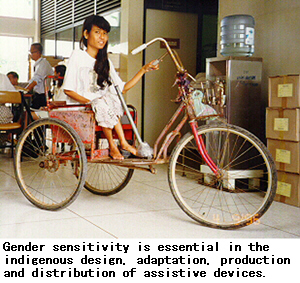
A. Need for assistive devices and production capacity
According to a survey of the National Statistics Office, in cooperation with the Ministry of Public Health, there were approximately 1.1 million people with disabilities in Thailand in 1991, ie., 1.8 per cent of the total population of 57 million.
The number of people with disabilities who came to register with the Public Welfare Office around the country from November 1994 to July 1995 was about 80,000 (according to the Office of the Committee for Rehabilitation of Disabled Persons, Department of Public Welfare). Of these, about 66,712 needed assistive devices, compared to the 1995 Central Government Budget for assistive devices which could provide the devices for about 20,000 persons. This meant that only 30 per cent of even the need of registered people could be met through government distribution. There are, however, no official data on the production capacity of NGOs within the country. NGOs have played a vital role in producing and distributing assistive devices, especially to rural areas.
Assistive devices that can be made in Thailand include prostheses, wheelchairs (wooden and metal) for level propulsion, crutches and walkers.
The major problems that limit production are financial problems and a lack of technicians. The government budget is currently insufficient to meet demand. Also, support for research in using appropriate technology with low cost and high quality of local production has only just begun.
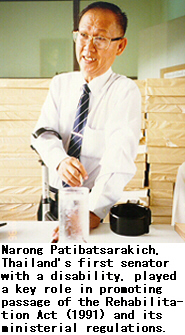
Much of the need for assistive devices in Thailand is met through import of raw materials, components, and machine tools from the United States of America and Germany. These include band saws, socket routers, socket duplicating machines, bending irons, polyester resin, nylon stockinette, catalyst DEA, plastic PVA, pelite, pigment colour, benzol peroxide, hardener powder, SACH feet, knee-shin components, and ovens for polypropylene sockets.
The only way for a NGO to get an exemption from import duties and taxes on assistive devices is to present an official document stating that the organization is working with the government. The process for obtaining an exemption could be time-consuming. The table at the end of this chapter describes import taxes paid by each enterprise. The difference in percentage terms for the same goods and the same enterprise is due to the difference in the quality of the goods.
Below are some steps in the clearance of goods through customs:
- 1. Issue airway bill.
- 2. Examination of all documents.
- 3. Goods examination, tax estimate.
- 4. Data entry of duty to be charged.
- 5. Customs authority examination and collection of duty and stamps.
- 6. Issue license card for the goods.
B. Policy
The ministerial regulations of BE 2537 (AD 1994), issued under the authority of the Ministry of Public Health, set up 13 kinds of medical rehabilitation services for people with disabilities who are registered under the Rehabilitation of Disabled Persons Act. The Sirindhorn National Medical Rehabilitation Centre, Ministry of Public Health, is the central agency in the country in charge of implementing the regulations. The provision of assistive devices is one of the medical rehabilitation services in the regulation. People with disabilities who have registered can ask for assistive devices to be supplied, repaired and maintained free of charge.
The two core policies that the Sirindhorn Centre has carried out in this area are to (a) give full support to people with disabilities in the supply, repair and maintenance of assistive devices, and (b) support the production of assistive devices within the country by both government and non-government organisations using appropriate technology, in order to decrease imports.
At present, the Sirindhorn Centre is working on establishing standards for assistive devices and standards for service provision. Each Medical Sub-Committee for Disabled Persons of the Ministry of Public Health has worked intensively on the particular criteria for different types of disability.
C. Repair and maintenance
Repair and maintenance services are mainly undertaken by workshops for production of assistive devices, including workshops in hospitals or production sites in rural areas. Otherwise, people with disabilities undertake repairs by themselves. The Association of the Physically Handicapped of Thailand, located in Nonthaburi province, provides the services of wheelchair and level propulsion repair and runs a maintenance centre.
D. Distribution
There are three main mechanisms for distributing assistive devices to people with disabilities: public hospitals (under the Ministry of Public Health), Provincial Public Welfare Offices (under the Ministry of Labour and Social Welfare), and local community-based rehabilitation (CBR) projects.
Under the Rehabilitation of Disabled Persons Act, people with disabilities who come to register with the Public Welfare Office (in each provincial capital) can also ask for assistive devices where some amount of government budget is prepared for this. Doctors examine people with disabilities and decide what assistive devices they think people need. Then prosthetic or orthotic technicians or experts make up the devices according to the doctors' requirements.
Many people do not come to register because of inaccessible transportation, high cost of travel, lack of information and so on, especially in rural areas. CBR projects, run mostly by NGOs, can serve their needs. People with disabilities and the CBR project staff work out a method to get the devices in the local area. Some projects have workshops producing assistive devices in the rural sites, or their staff can coordinate work with other concerned agencies from which they can obtain the devices.
E. Technology
Both electrical free-standing machines and electrical hand tool techniques are used in production in the country. Types of technology used are listed below.
- Equipment used includes: vacuum pumps, ovens, drills, "turrets", plaster smoothing tools, and socket routers;
- Types of components made within the country include: soft sockets for below-knee amputees, prosthetic feet, and cosmetic foam;
- Raw materials indigenous to Thailand include: wood, resin, leather and pelite (for soft sockets);
- Types of components imported include: shanks, polypropylene, knee joints, adaptators, and feet (the Seattle, Otto Bock, Kingsley and until recently, Khmer feet).
F. Personnel
In Thailand there are two kinds of technicians: graduate technicians and non-graduate technicians. Non-graduate technicians mostly work in district hospitals or as assistants of graduate technicians in provincial hospitals. There are orthotic and prosthetic experts at the Sirindhorn National Medical Rehabilitation Centre (SNMRC).
The different categories of technicians are: prosthetic and orthotic technicians (graduate and non-graduate); orthopaedic shoemakers (graduate with low technical level); brace makers; and mobility aid technicians (graduate and non-graduate).
The duration and subject areas of the training curricula of those techni cians are:
- Orthotists and prosthetists (graduate): three years' training;
- Shoemakers (graduate): six months' training;
- Orthotists and prosthetists (non-graduate): seven weeks' training with follow-up by a Handicap International orthotic/prosthetic expert. The curriculum and training are recognized by the Sirindhorn Centre.)
Training for technicians in making wheelchairs and walking aids is also available.
Apprenticeship schemes include five weeks' training by Handicap International at SNMRC in making resin prostheses, followed by two weeks' examination. The major vocational college is the prosthetics and orthotics workshop at Lerdsin Hospital. The most important graduate institution is the SNMRC.
Most of the technicians are employed by the Government.
G. Institutional support
Support for the indigenous production and distribution of assistive devices in Thailand has been provided by the following:
- Government agencies: Sirindhron National Medical Rehabilitation Centre, Ministry of Public Health, Department of Public Welfare, Ministry of Labour and Social Welfare;
- Private companies: Siam Tyre Co. Ltd. and Otto Bock;
- NGOs: Handicap International, APDP, CBM, FAP, FD, FEPB, FWMR, HAP, Hilton/Perkins, ILSMH, NAD, NCSW, TRMA, Sai Jai Thai Foundation, and Rotary Club (Shapemaker).
H. Technical cooperation
The Sirindhorn Centre (under the Ministry of Public Health) and the Department of Public Welfare (under the Ministry of Labour and Social Welfare) are the government agencies willing to work in a coordinated way for technical cooperation. The Association of the Physically Handicapped of Thailand offers technical exchange programmes with countries in the region concerned about wheelchair production, repair and maintenance.
Table: Import Taxes Paid by Importing Enterprises
All figures are in percentage terms.
|
Otto Bock (Germany) |
Rehabilitation Co. Ltd. (United States) |
U-FAM (Germany) |
|
| Polyester resin | - | - | 30 |
| Nylon | - | - | 45 |
| Catalyst | - | 30-60 | - |
| Plastic | 45 | 45 | 45 |
| Pelite | - | - | 45 |
| Pigment colour | 20 | 35 | 30 |
| Benzol peroxide | - | 35-60 | 30 |
| Hardener powder | 22 | 35-60 | - |
VIET NAM *
* By Dr. Le Thanh Do, Expert on Rehabilitation, the Orthopaedic Rehabilitation Institute, Ministry of Labour, Invalids and Social Affairs, Hanoi.
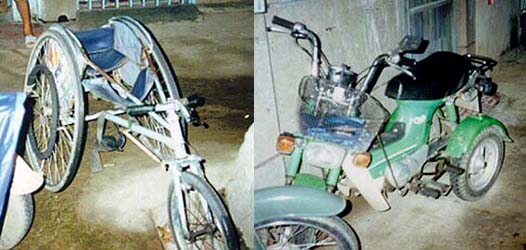
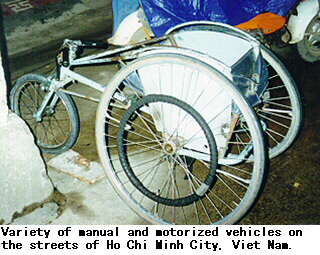
A. Need for assistive devices
Assessment of the overall need for different types of assistive devices is based on the Report of Fundamental Investigation of the Orthopedic Rehabilitation Institute and the statistical yearbook (statistical almanac) of the Ministry of Labour, Invalid and Social Affairs in 1993. About 20,000 devices are needed each year.
Most devices are produced locally, although components and materials are imported. The main imports are plastics used in artificial limbs, and ball-bearings for wheelchairs. The Viet Nam orthopaedic branch has imported some components which have been used to produce artificial limbs using a CAD/CAM system. These components were donated from the United States of America or by NGOs. Customs procedures for importing assistive devices are simple, and the import is free of taxes and duties.
About 92 per cent of the overall national need for assistive devices is met through local production. The most important local factories producing assistive devices are Ravi Mechanical Orthopaedic, Thuykhe Leather factory and Hanoi knitted goods factory (the latter for special socks).
B. Policy
Viet Nam has an explicit government policy for the indigenous production, import and distribution of assistive devices. Its elements are the following:
- (a) Use mostly local materials to produce assistive devices;
- (b) Import only key materials that cannot be made within the country;
- (c) Distribute assistive devices to all people with disabilities in Viet Nam.
The Government encourages orthopaedic rehabilitation centres to take full advantage of local materials to produce assistive devices for people with disabilities. It also encourages centres to improve the quality and decrease the cost of production so that devices are easier to use in society, and decrease cost of production so that society can accept them.
Viet Nam has a set of national standards for assistive devices concerning materials, skills of technicians and the quality of the production line. The national standards body is headed by the president of the scientific body of the Ministry of Labour, Invalids and Social Affairs. It includes experts from the scientific orthopaedic rehabilitation institute and from orthopaedic rehabilitation centres. Its address is 12 Ngo Quyen Street, Hanoi, Viet Nam.
C. Production capacity
About 2100 assistive devices (including wheelchairs, tricycles, artificial limbs, orthopaedic shoes, orthopaedic braces, orthopaedic corsets and other prosthetic devices) are produced each month in Viet Nam. These devices are produced both at state and provincial levels by the workshops of orthopaedic rehabilitation centres and a scientific orthopaedic rehabilitation institute.
Potential production capacity in Viet Nam is estimated at:
| units per year | |
| Artificial limbs: | 20,600 |
| Orthopaedic devices: | 1,860 |
| Orthopaedic shoes: | 5,400 |
| Orthopaedic braces: | 1,600 |
| Wheelchairs and tricycles: | 825 |
Production is limited in Viet Nam because of financial constraint and a lack of materials.
D. Repair and Maintenance
Repair and maintenance services for assistive devices are provided by the workshops responsible for their production.
E. Distribution
Assistive devices are distributed, at government expense, to all wounded soldiers. Wounded soldiers must obtain a certificate from their provincial or city Department of Labour, Invalid and Social Affairs, to prove that they are wounded soldiers. They can then obtain devices from local orthopaedic workshops free of charge.
Other people with disabilities must appproach these workshops directly and pay for their assistive devices. It is difficult for poor people with disabilities to buy them. Assistive devices could be distributed freely to all people with disabilities around the country, without discriminating between young and old or rich and poor, if there were a project that could provide the necessary support in the orthopaedic area.
Go back to the Contents
ECONOMIC AND SOCIAL COMMISSION FOR ASIA AND THE PACIFIC
Production and distribution of assistive devices for people with disabilities: Part 2
- Chapter 13 to 16 -
ST/ESCAP/1774
UNITED NATIONS PUBLICATION
Sales No. E.98.II.F.7
Copyright © United Nations 1997
ISBN: 92-1-119775-9
